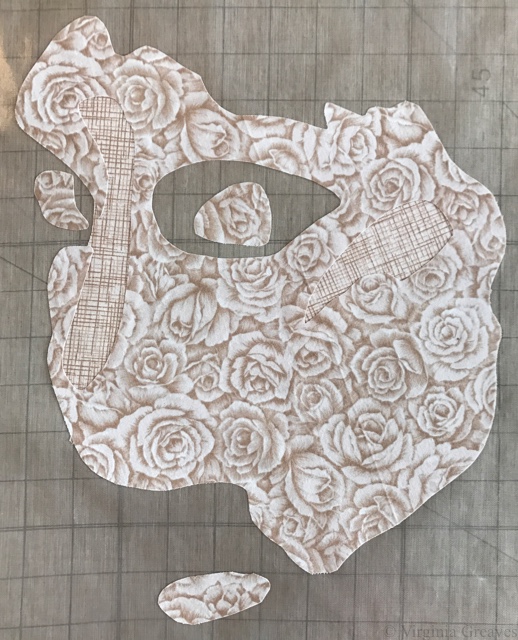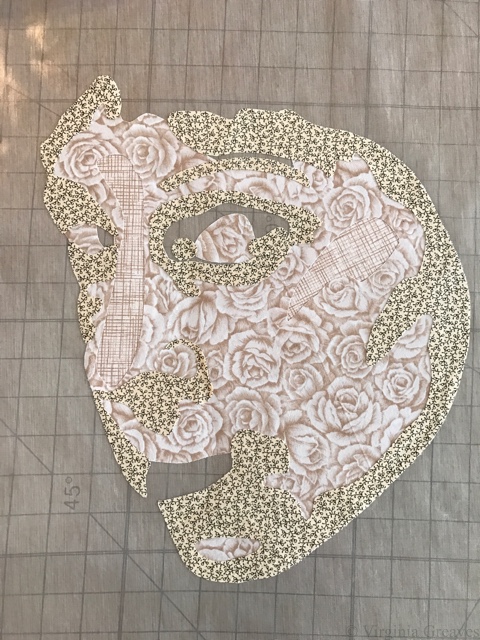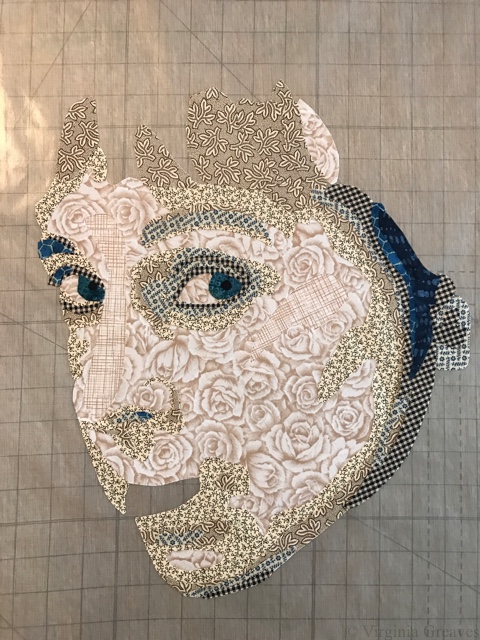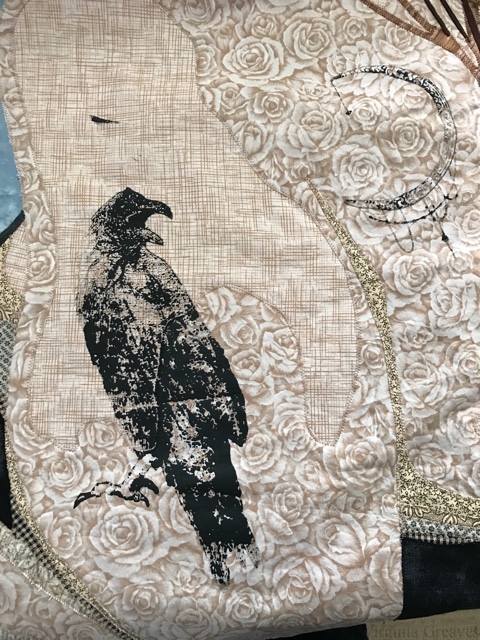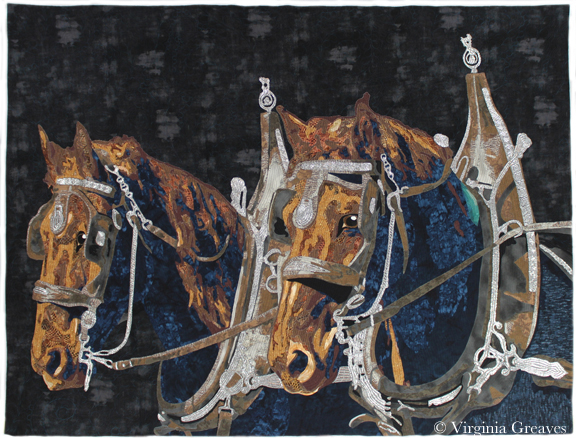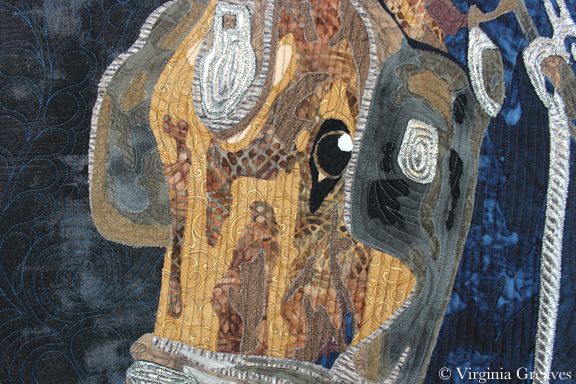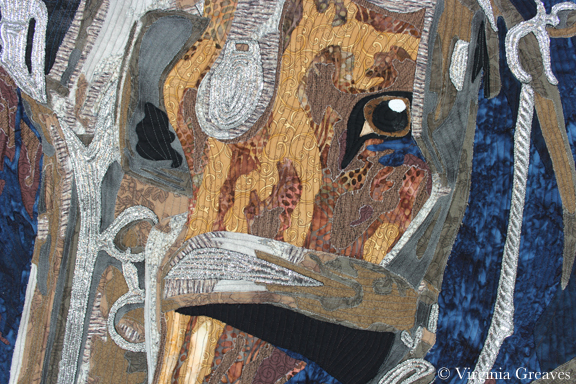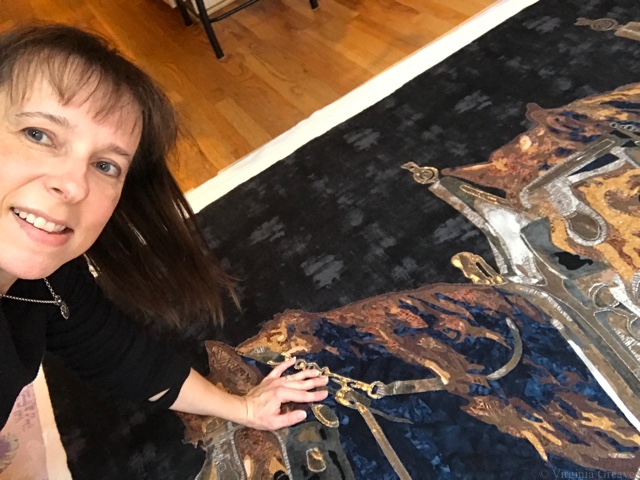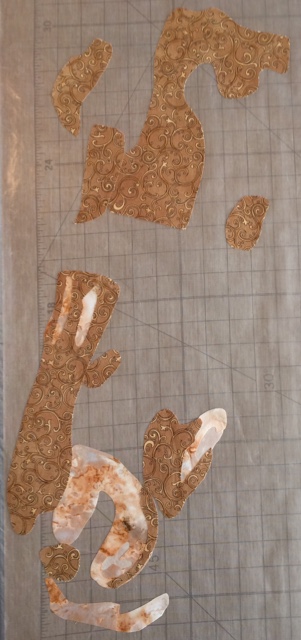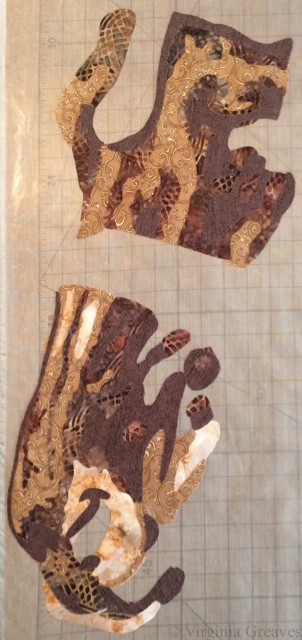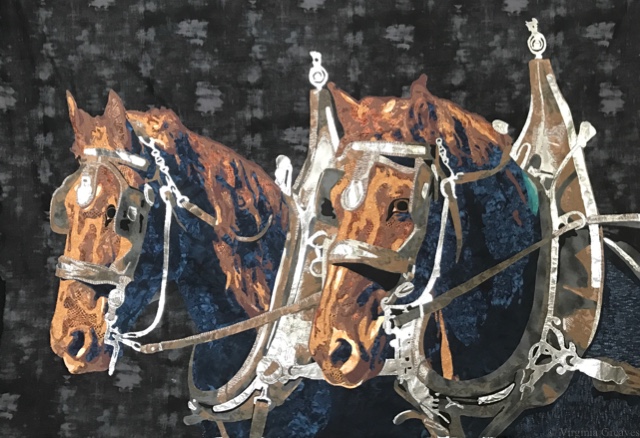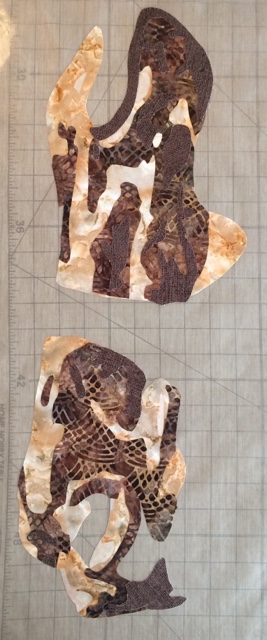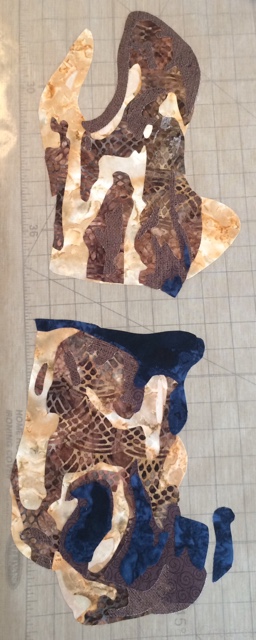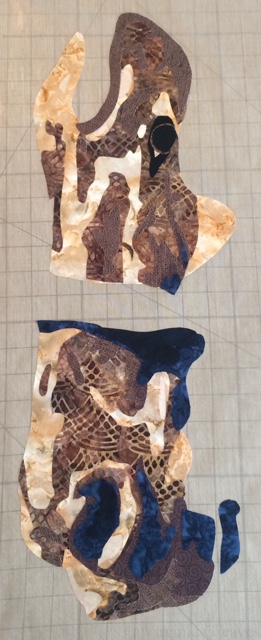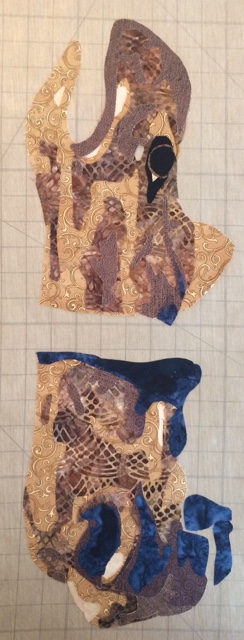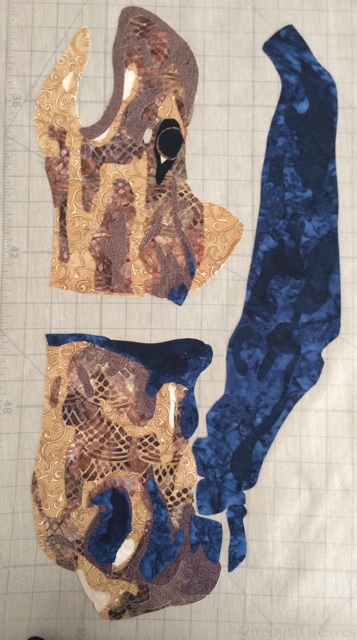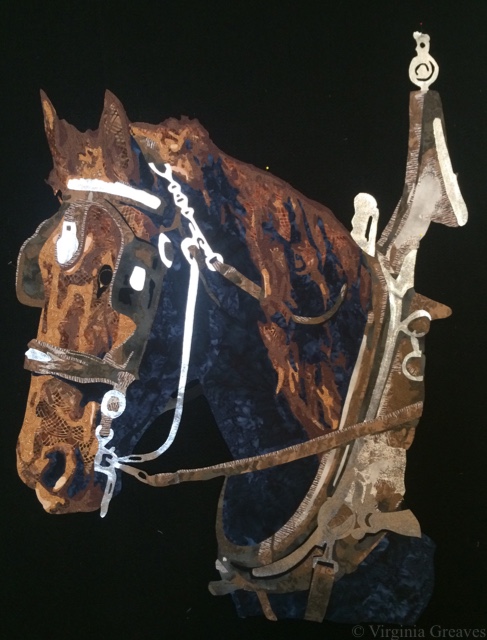Virginia Greaves
(7 comments, 341 posts)
This user hasn't shared any profile information
Home page: http://www.virginiagreaves.com
Posts by Virginia Greaves

Sanctimonious
0I found this in my draft folder — from December 2017. It shows the work I did on a small piece — only cat I’ve ever done. Titled Kneel Before Me. I thought it hadn’t been exhibited anywhere, but I did make a page on it, and I recorded there that it has been shown once — in an exhibit that heralded COVID & the closing of everything. I don’t know that I’ll return to this type of appliqué work. It’s very time-intensive, and I work full-time now.
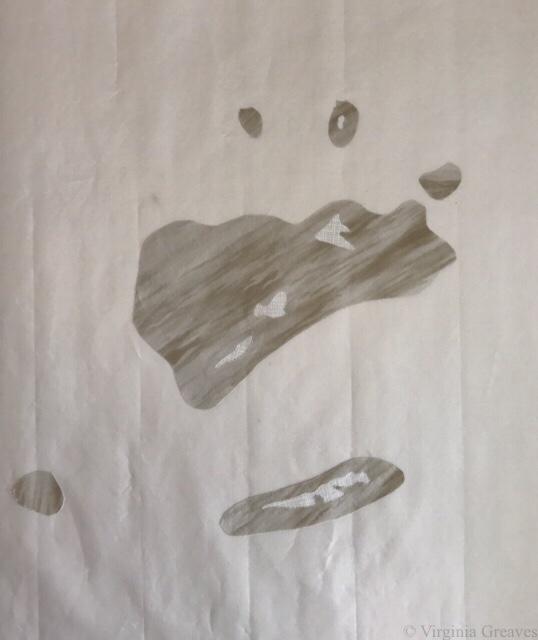

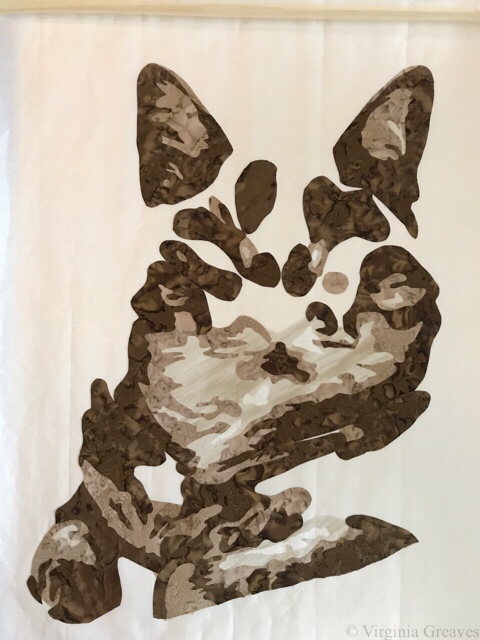
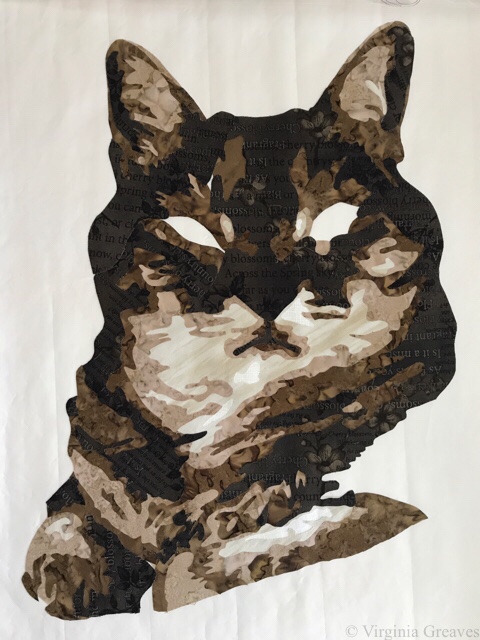
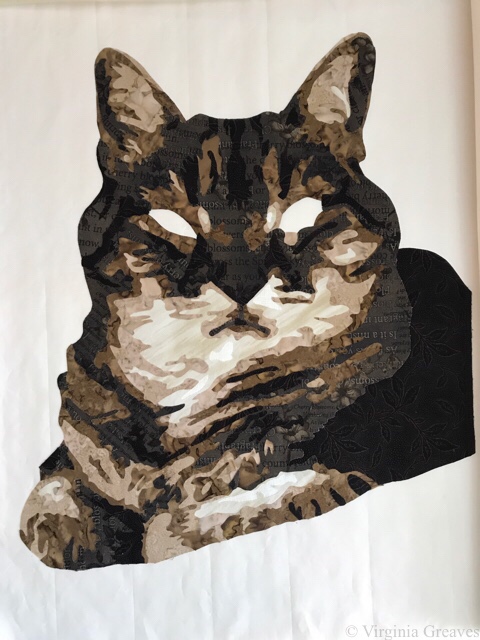
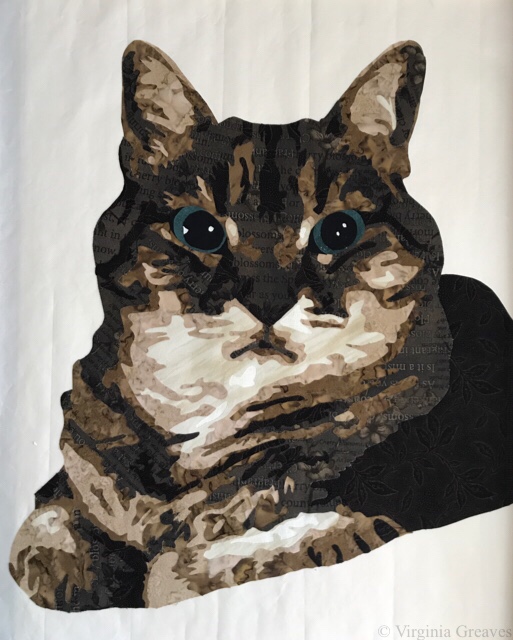
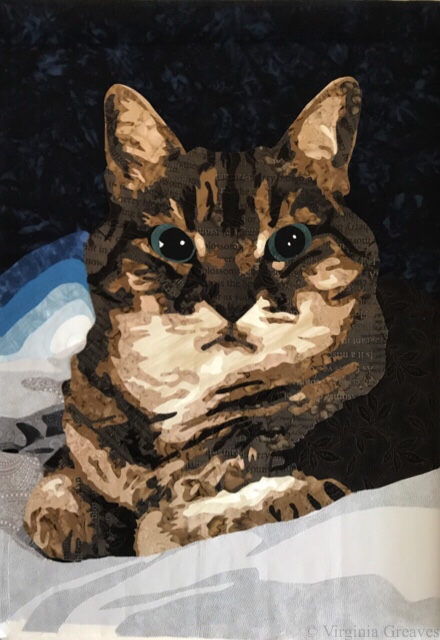

Be Creative Cover Girl
1I have the honor of being the cover girl for Be Creative’s current issue of Be Inspired, volume 6. It’s on sale now at www.creativewithworkbox.com and will be available in stores starting November 10th.
If you want to see the article, you can read it here (with permission from the publisher): Be Creative: Creating Order From Chaos

2017 IQA Auction
0This year I wanted to make another animal portrait for the IQA Silent Auction in Houston. I think they’re easily relatable and are a good choice for broad appeal for the auction.
I was going over my inspiration folder and found this adorably cute Cavalier King Charles spaniel which I thought I could do rather simply. Oh, the best laid plans. See, I fell in love with this piece as I worked on him. I spent way more time than I had intended, but he grew under my hands into the adorable creature that had captured my heart in the photograph. I’m really fond of this piece.
This shows the 1st two values.
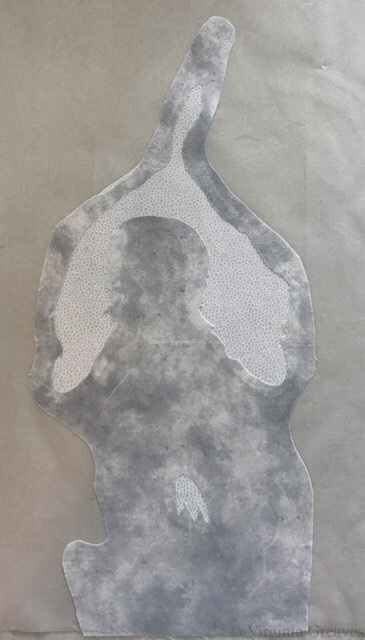
And the 3rd.
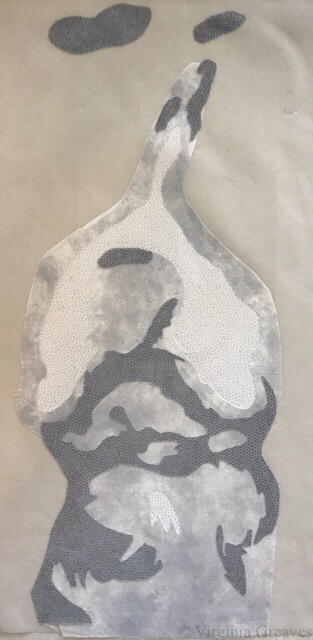
Although he’s all black and white, there are a couple of points of orange. I studied the spots above his eyes. Logic told me that the color was brown, but no, it was really fairly orange, although the darkest orange tends toward brown. I decided it would look better underneath the black fabrics rather than on top, so they were added at this point.

And then the 4th value. Now you can see the outline of the nose and the mouth.

The fifth value. I took this pic on my iPhone at night in my studio so the grays look darker than they actually are.
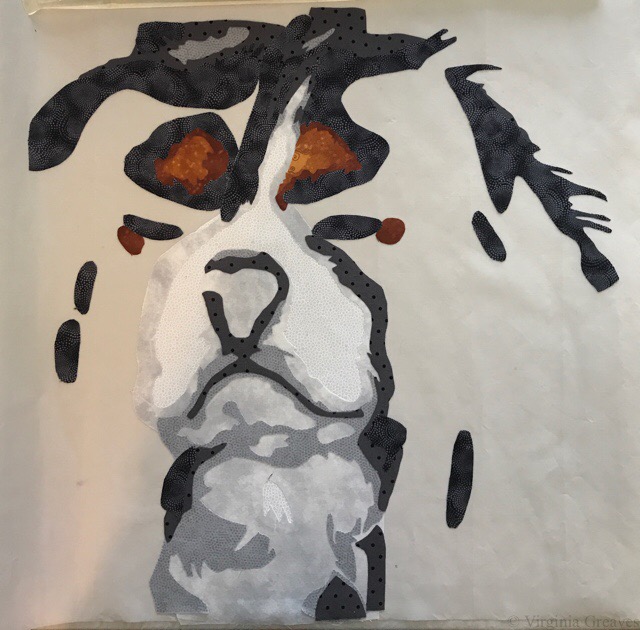
The 5th value.

I realized at this point that I had neglected his nose and went back to do that.
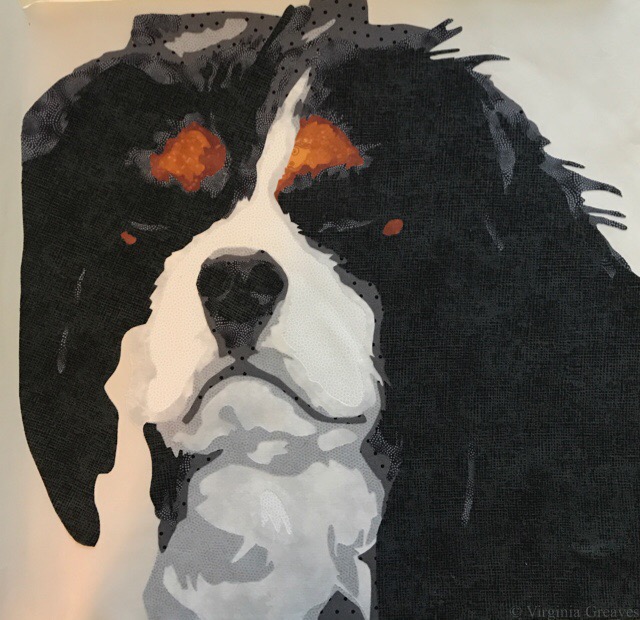
And then the last value. Better picture.

I played with his eyes quite a bit until I got them just right. The pupils were bigger than I had anticipated, but this gives the expression I was looking for. Isn’t he charming? The eyes really do make the piece.
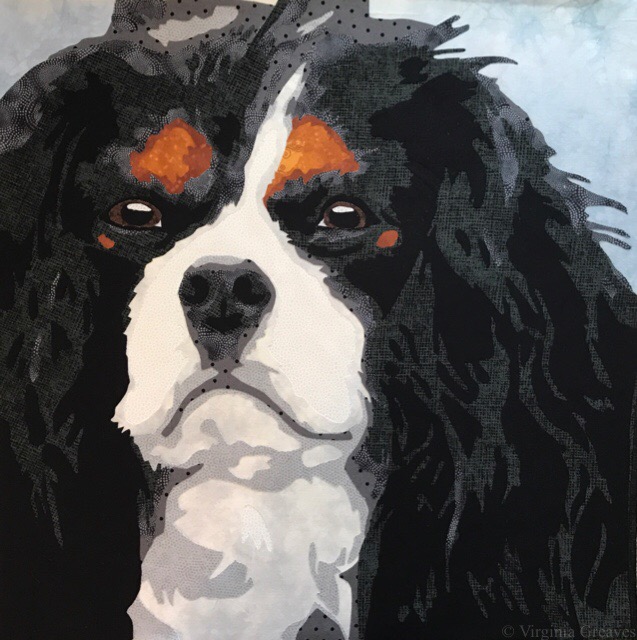
And then because I could, I went back and added some whiskers.
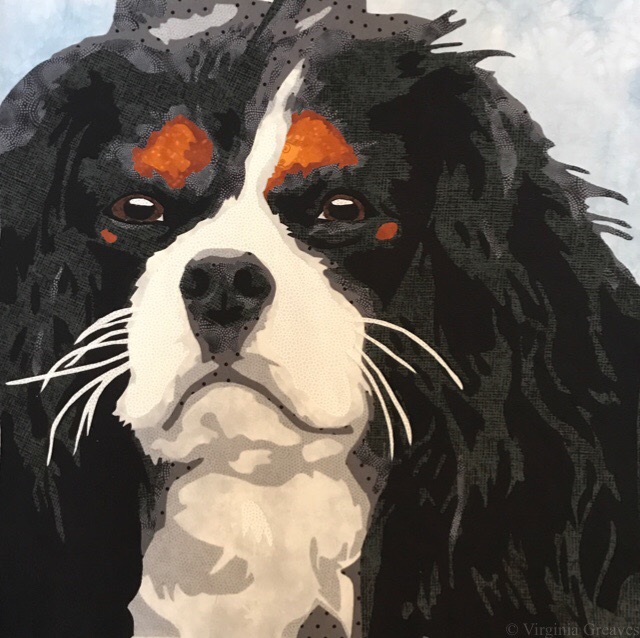
This is what he looked like all cut out. I spent several hours machine appliquéing him down and quilting him.
 The final pice is called King Charles and can be found in its quilted and completed state on its own page here.
The final pice is called King Charles and can be found in its quilted and completed state on its own page here.
It will be available for sale in Houston at the Silent Auction in November 2017. I hope that you’ll consider bidding on it. I’ll mail him off this week — be a little sad to see him go.

Brindled
0Although I’ve made many dog portraits, my current pet is brindled, something I despaired that I would never be able to capture in fabric. A brindled animal is typically brown with streaks of black. It’s very distinctive. Given the nature of closed shapes in appliqué, I didn’t think that it was something that I could recreate. However, I was speaking with one of my SAQA mentees recently, and she had tried it in her work with success and encouraged me to do the same. It’s all about the fabric.
So for this piece, I chose a picture I had taken of her with her great big tongue curled up over her nose. It showed a lot of her personality. I searched through my pinks for just the right ones and started there. I could have put the tongue on last but worried about the darker fabrics I would use for her fur showing through, so I started with the tongue.
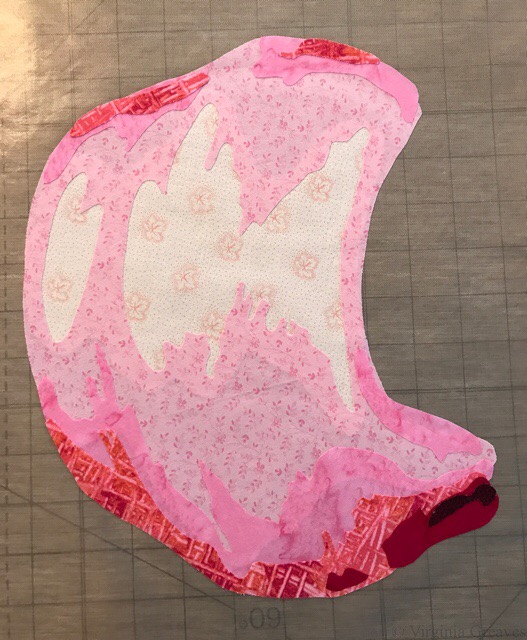
And then after the tongue, I went on to the wet nose.

And then the hard part — the fur. I chose highly textured browns. These are the first two values, although there’s only the tiniest amount of the lightest brown up there in the top left-hand corner.

This is the 3rd value — not a very clear pic but probably taken late at night in my studio. Did I mention these are flat on my drafting table and I’m standing above them on a ladder taking the pics?

And here, with the next value, you can start to see the magic happen. The textures start to blend together but still maintain their integrity.
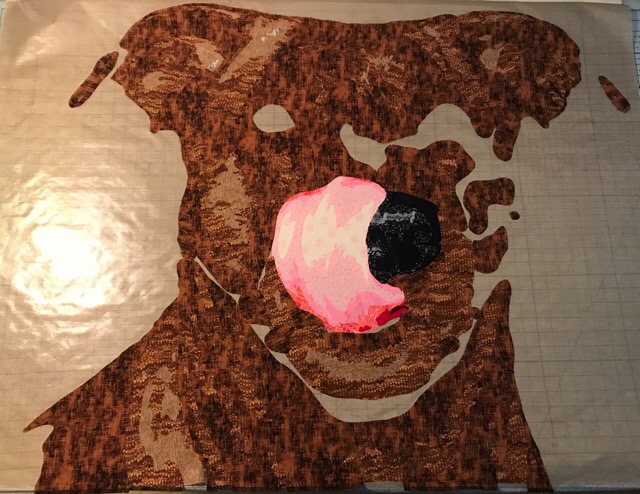
The next value.
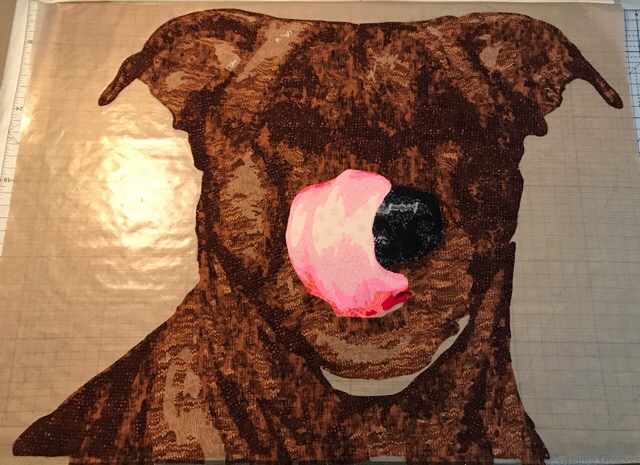
And the darkest value.

The eyes always make a big difference. It was interesting finding a brown iris color that wouldn’t blend into the fur.
And then this is the background I went with. I cut strips of green and randomly assembled them for the background to give an abstracted look.
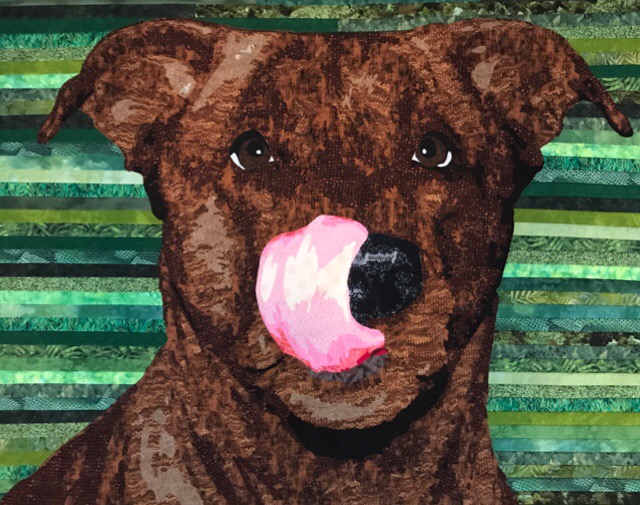
And this is her. This is what she looks like. This is the piece before quilting.
I almost finished this piece in July but a confluence of activity prevented that from happening — so it was finished in early August. And then I was able to then create a piece from beginning to end for the IQA Auction by the end of August. No idea how that happened. I will share pics of that one in another post.
 I named it Tasty, and you can find it once quilted and completed on its page here.
I named it Tasty, and you can find it once quilted and completed on its page here.

Making Tattoo
0Woohoo! My first piece in Dinner@8! I know there are a lot of you that can’t comprehend what a big deal this is, but it’s kind of like winning the lottery. It’s a juried invitational show, so I had to apply to be a part of the Dinner@8 group in order to be invited to make a piece for the current year’s show. After I was accepted, I made a piece according to the theme, which this year was Personal Iconography: Graffiti on Cloth.
I haven’t shown the piece in process on the website because that’s a no-no in this show. Virgin rules, except you can post after acceptances go out.
I’ll admit that I was stumped by this year’s theme. My goal, just as I did the Yvonne Porcella piece (Yvonne in the Garden), was to make a piece that was wholly in my style while still working within the framework of the theme, but I knew that doing that with this theme was going to be hard. I knew that I was going to make a portrait of a person, and I spent some time thinking about how tattoos are so personal and would work well within the theme. My daughter has several tattoos, and she spends a lot of time considering the symbology of each piece and finding the right artist before she gets them. I wanted to honor that, but I also knew that finding a female model would be hard. I envisioned a back shot with the main tattoo on the arm. I’m not entirely sure why, but it seems to me to be a deeply personal pose, enough that I didn’t know anyone personally that I felt I could ask. And really, who’s always available? (Me.) Thank goodness I have a remote control for my camera. I set it up in my studio, and by the end of one afternoon, I had a series of shots I could work with to create what I had in my mind.
I started with the shoulders and back first since the hair would drop over the back. I usually start with the face, but in this instance, the shoulders made more sense. This is the first couple of values.
This is the 3rd value. I ran out of the fabric — or rather ran short on it. I knew I needed enough to cut out for the face and decided that I needed to supplement with a fabric that was close. I could use it on the extended arm and the change would be less visible. (This prompted a late night run to JoAnn’s as it was the only thing open at the time, & I was in the creative head space to keep moving forward.)
This is also the point at which I realized I needed to complete the hand along with the arm — and make sure I had enough fabric to do it as well.
And then I added the deeper values, a dark tan and a couple of dark blues — and then the black garment.
And then I started on the face using the same fabric. These are the first two, and you can just see the basic outline.
This is the 3rd value, the one that I ran out of. I’ve had this fabric for a long time, and I’ll have to try to replace it. (Never let anyone tell you that calicos don’t have value. They’re wonderful for faces.)
This is the 4th value. It inadvertently looks a little like horns, but really, that’s just my high forehead that will go under the hair.
The 5th value. You can tell I was working at night in this one.
And then the rest of the darkest values. I leave the main parts of the eyes and the mouth for the end, so at this point, she looks a little bit like a zombie. I did play around with the darks around the eyes a little bit. I naturally have very dark circles around my eyes, but it wasn’t aesthetically pleasing in the piece, so I backed off on the value a little. (This is part of what I call creative license. Do what’s best for the piece and don’t feel tied to exact duplication of the photograph.)
These are the eyes. Not quite right. I almost always freehand cut these nowadays.
And in this one, a darker blue around the rims of the irises and larger pupils. Then I made the teeth (or the suggestion of teeth) and the mouth.
I did go back later and make the eyebrow on the right darker.
I spent quite some time trying to figure out how I would do the tattoos. I wanted them to look like dotwork tattoos, and so screen printing seemed the way to go. I had, years ago, done some screen printing. What could go wrong? I drew the tattoos in my sketchbook, scanned them, skewed them in Photoshop so they would look as if they were on an arm and tilted across the back, and sent them to Fiber on a Whim to be burned to screens. After fusing my figure to a background and appliquéing it in place, I then screened them right on my piece. What was I thinking? The moon is clean but way too light, and the crow is a mess. I even have a paint blotch above the crow’s head.
With the moon, I just grabbed a fabric marker and filled in all of the light spots to clean it up.
The crow was much harder. I think it sat on my ironing board for at least a week while I thought it over. No use crying over split milk. I had leftover fabric, so I made a bunch of screens of the crow until I got a decent screen. I now have mad appreciation for anyone that screen prints, especially to fabric. It’s much harder than it looks to get a clean screen print.
On the finished piece, I cut out the crow and the blotch. I had to pick out appliqué stitches in two places. Those will be covered by the new crow.
Then I took the new crow, cut around the crow shape, and then fused it onto the arm. I also made a patch to fuse onto the area of the blotch that I had to cut out. Then I ran an appliqué stitch around the crow and the patch. I worried that it would be too obvious around the bottom area where the fabric value is darker, but it’s hardly noticeable on the final piece. There’s only about a quarter inch of light fabric around the crow, and it blends with the fabric it’s next to. In the end, it was a good solution to a difficult problem.
As I was making the piece, I thought it would be cool to add graffiti to the background. That’s why I went with a solid blue background. I even studied graffiti shapes and practiced lettering. I made the graffiti, but then I decided it was too much of an in-your-face interpretation of the theme — so I took them off. That was much worse. So I spent time thinking about the background — and about how I approach my work. In the end, I decided that I didn’t want to be safe, and leaving off the graffiti was safe. Keeping them on there gave the piece a vibrancy it didn’t have without them. So I played with their placement and added black outlines to them and some sparkly points.
You can see the final piece on the Tattoo page here.
Tattoo will premiere in the Dinner@8 exhibit at International Quilt Market & Festival in Houston this coming October/November.

Wash & Wax article in Be Creative
0
What’s in a Name
5I have finally completed the horses. I spent almost 137 hours on them. The bulk of that time was cutting and fusing, which was over 63 hours, and then I spend almost 30 hours quilting it.
As noted before, I used my home machine, a Janome 7700. I just set up extra tables all the way around to hold the weight of it as I quilted it. I also practiced drawing my background design from all angles so I wouldn’t have to move the quilt around as much.
This is detail of the first horse on the left — shows some of the intricate background quilting.
This is detail of the second horse on the right.
And now I’m faced with naming this piece. When I hear the song Renegades by X Ambassadors, that feels about right. To me, the horses are renegades in the sense that they’re rebellious and unconventional. However, if you look up the definition of renegade, it’s a traitor or deserter — which isn’t right at all.
They are military horses used in cavalry, and Calvary might make a good name — or War Horses.
If you have an opinion on a name, please leave a comment. I would love to have some input.

How to Eat an Elephant
5Often, I wonder what to name a blog post — but not this one. At first, I was going to title it, Nothing is Ever Easy. That’s what I had in my head as I started this morning, but it quickly turned into How to Eat an Elephant.
My Elephant is the Horses. I have been holding off quilting it until I took a long-arming class at my local quilt shop. I had it in my head that, because of its size, I had to put it on a frame. So I worked on every other project in my house while I waited for my class, which I had last Saturday — except it wasn’t what I thought it would be.
I was very lucky to be given the chance to sew on four different HandiQuilter long-arm machines. The 1st was the Sweet 16 which was set into a table. I was sure that this was NOT the one for me. The next model up was the Simply 16 on a small frame, then the Avante on a full sized frame, and finally the Fusion on the largest frame. I had my eye on the Avante.
There were three other people in my class, so we rotated through the machines. I started with the Simply 16 on the smallest frame. Although I don’t normally quilt a lot of feathers, I decided that it was a good place to start. I was so surprised that I couldn’t make the petals come back to the stem. It was really hard to control. And then I worked on the Avante, and it was better, but not a lot. The machine was not moving as I wanted it to. The teacher suggested that I was too used to free motion quilting with my hands guiding the piece, rather than guiding the machine over the top of the quilt. Then I tried a pantograph on the Fusion. I’m not the least bit interested in pantographs, but it seemed to be the highlight of the class to everyone else, and it was a good exercise to just follow a drawn line. It was hard to do too.
And then I sat down at the Sweet 16, and I just quilted. It felt natural, and my feathers looked great. I was in control.
<sigh> I knew by the end that there was no way that I could put the horses on a frame. It’s possible for me to develop the skill over time, but it’s not something that’s going to happen quickly. Renting by the hour at the local shop, I don’t know that it will ever happen. The skill set that I’ve developed is just not as translatable to a frame as I wanted (& needed) it to be.
So I came home and knew that I was going to spray baste my quilt and start quilting it here at home. I may take it to the shop towards the end, when it’s at its heaviest, when I’m quilting the background, and see if the Sweet 16 is a big improvement over quilting it at home, but the table, even with the extra side pieces, is not very big. Here at home, I’ll set up many tables around my machine, and although I’ll have to crawl on the floor to get out of my studio, hopefully it’ll hold the length of the quilt as I’m working on it so gravity won’t be working against me.
And today, I laid out my sheet in the kitchen, I taped things down, and I started spraying. I do wish that I had put down a second sheet as I had quite a bit of overspray onto my wooden floor. My poor socks are covered in a layer of spray glue. But it’s done. My back hurts, but it’s basted.
At least there was no one here to laugh at me as I crawled around on the floor, smoothing it out.
When I was done, I took it upstairs and made sure the back and front were perfectly smooth. I always find that, even with taping, I have a few lumps and wrinkles that need to be worked out. Thank goodness the spray basting allows me to reposition everything until it’s smooth.
Now it’s ready for quilting. Wish me luck. I think I might need it.

The Creative Spirit
2I’ve been hard at work in my studio since my last post, pouring the creative spirit out of me and into my work. And I’ve surprised myself.
If you remember, I had finished the first horse, so I began cutting out the second horse, its companion. This shows the light values of the face.
And then the darker brown values.
And finally the darkest brown values.
Here is the horse head without all of the leather straps, bridle, and silver.
Then I added all of the leather parts around the face.
And finally the leather collar.
Once I added the silver, I put it up on the design wall for a quick picture.
At this point, I put it up next to the other horse to see how it would look. Wow. I loved it on the black, but I always do.
I considered for a while making a pieced background, but I finally decided that the horses themselves are so intricate, a pieced background would only create a distraction. I found a great smudged black that works well.
This is both of the horses appliquéd onto the background. The grays in the background black look lighter than they actually are — my camera phone is limited in its range and chose to highlight all of the silver. The final photographs after quilting will be difficult, but this piece may warrant my first trip to a professional photographer.
For those interested in the process, I abandoned my usual appliqué technique, which is a tight zigzag around all of the rough edges. Even a free-motion straight stitch around the edges as an appliqué technique was difficult as the pieces tried to pull off as I worked on it. The horses were large and complex, and Wonder Under can only hold so well. The silver, especially, didn’t want to adhere. It was always the first appliquéd for each of the horses.
And the end result is more artistic. I’m letting go of the restrictions of the quilt world and embracing the art side. The free motion stitch is much more like drawing on the piece. I still haven’t decided if I’ll add some tulle for added protection to the raw edges.
They each have their own personalities, and I’m surprised at what has crawled out of my brain.
And now I begin thinking about the quilting process. I have a hard time just pinning this on the wall by myself because it’s so large. I tried to take a local long-arm class at the beginning of the month but it was full. The next one is not until the first of December, and I don’t know that I want to wait, but I’m also uncertain about tackling this bear of a piece on my local machine. I do happen to have a Hinterberg frame that I bought years ago — it sits in pieces in the corner. I abandoned it when I realized that my Viking didn’t have enough harp space for me to use it on the frame. But I did get another 4.5 inches, I believe, in harp space when I upgraded to the Janome. It might be worth trying it.

For the Love
2So after finishing Minerva and going through my Quilt National rejection, I needed a new direction in my work. So I was flipping through photographs that I’ve taken, and I found one of two horses in full military gear that I took during the Gold Rush Parade in Dahlonega last year. I knew instantly that it was going to be my next piece.
It’s the first piece in a while that I haven’t made for a show theme, and I gave zero consideration to marketing it. I am making this simply because I want to, which appears to be feeding my creative muse in a positive way.
And almost unconsciously, I have made this piece huge — which is funny, because two years ago, I would have made something that would fit the size of my table. I suppose I felt the need to make these life size. So the general size of the pattern that I’ve made is 48″ long by 69″ or so wide. And let me just say that making a piece in this scale is daunting. I have broken it up into sections to make it easier — I’m making each horse separately — and for each horse, I make the face, and then the rest of the head, and then the back, and then the neck, and then all the leather, and then all the silver hardware. It still causes unique difficulties. I’m not sure that I can appliqué it in the same way that I usually do — certainly not all at once — maybe not even one horse at a time. And there are so many pieces in even just the first horse, I’m considering doing what I did with the auction piece I did for IQA, Loyal, and using a straight stitch around the shapes instead of my usual zigzag — maybe even incorporating it into the quilting in the same way I did Loyal. I’m even considering covering the piece with tulle like Susan Carlson does, to provide another layer of protection for the raw edges.
But all of that discussion in my head is not while I’m in my studio. In my studio, I am in the zone.
For this piece, the first 2 values are very light — in fact, I probably could have dispensed with the lightest and just used the batik here. It’s hard to discern where the first value even is.
And this shows the 3rd and 4th values. The 3rd value is a batik I’ve always struggled with, but I think it works well here.
For the 5th & 6th values, I purposefully went into navy blues. Painters sometimes use blues for shadows, and I love the richness it gives the piece.
And then I had to construct an eye. In the photograph, there’s a piece of leather to the right of the eye that mostly obscures it. However, it’s important for the piece to have a successful eye. It’s a large part of what draws in the viewer’s eye. So I found a pencil and drew out what I thought would work.
And then I stepped back and really looked at it. I wanted to make sure that the fabrics were working before I continued — and they’re just not. There is a definite value change between two and three, but the step is too great. The horse looks more like a palomino with spots. So I went back to my fabrics and pulled out a honey yellow. Much better, and I can see the first value now.
I recut all the pieces and carefully peeled away the fabric that wasn’t working and re-fused it back together. And then I started on the neck. All the spaces are for leather bridle, harness, et cetera.
And then I went to work and stopped taking pictures. But as you can see, I worked one section at a time so I wouldn’t be overwhelmed. I had fused down all of the horse pieces before doing any of the leather or silver. Here is the horse completed with the leather.
And then here it is with the silver. The only thing I really questioned was the chain running from the top down to the mouth. There really wasn’t an easy way to do it. I may go look for some silver braided trim to use instead.
At this point, she’s finally off the flat table and pinned up on my design. She’ll be the far left horse — that’s why so much of her body is in deep shadow. The forward horse on the right will have a lot more of the brown detail.
I have a few drafting things to finish before I start cutting out the front horse. I also think that I’ll change the horse fabrics a little. I don’t think I’d have enough fabric to make the other one completely anyway. It’s amazing that I was able to get this far without making a trip to the fabric store — well, except for the silver.
And yes, this is silver spandex, just like the gold spandex that I used in The Last Supper. This time I was smarter and fused a non-woven interfacing to it before cutting it out to help control stretch, and then I added the fusible. Last time, I only used the fusible and it was harder to control.





